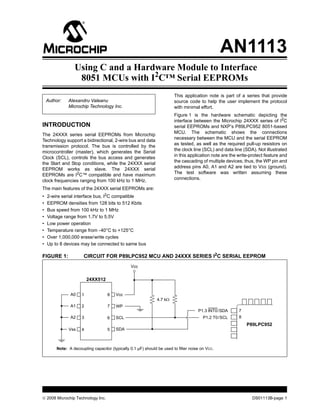The document describes how to interface an 8051 MCU with I2C serial EEPROMs. It provides source code and explanations of the necessary hardware and software. The hardware schematic shows how to connect an 8051 MCU to a 24XXX series I2C serial EEPROM. The source code demonstrates byte and page access methods for reading and writing data. Key I2C functions like start, stop, and repeated start conditions are analyzed. Timings and bus signaling are illustrated with oscilloscope screenshots.



![AN1113
INITIALIZATION START DATA TRANSFER
Initialization consists of initializing the hardware The MCU generates a Start condition on the I2C bus to
peripheral within the MCU. It performs the following initiate data transfer.
actions: Figure 6 shows a typical scope plot from the beginning
• I2EN = 1; //enable I2C part of a write operation. Any memory access begins with a
• CRSEL = 0; //select internal baud Start condition. This is followed by the I2C serial
generator EEPROM (slave) address (A0h). Because the R/ W bit
• STA = STO = SI = AA = 0; //clear Start, is set to ‘0’, the next operation of the bus is a write.
Stop, serial flag, ACK bit
• Sets the bus speed at ~75 kHz: I2SCLL =
I2SCLH = 25
The bit frequency (fbit) will be:
EQUATION 1: BIT RATE
fPCLK
f = -------------------------------------------------------------
-
bit 2 × [ I2SCLH + I2SCLL ]
FIGURE 6: I2C START BIT AND SLAVE ADDRESS
S
Bus Activity T
MCU A Control Byte/
R Device Address
T
SDA Line S10 100 000
Bus Activity A
C
K
DS01113B-page 4 © 2008 Microchip Technology Inc.](https://image.slidesharecdn.com/01113b-121014095010-phpapp01/85/01113-b-4-320.jpg)







![AN1113
BYTE WRITE VERSUS PAGE WRITE The following summarizes the differences between the
byte write and page write methods.
At first glance, the page write method appears superior
to the byte write method: it’s simpler and faster. Byte Write
However, a careful analysis shows that the byte write
method has a major advantage over page write owing • Is slower – It needs a 5 ms write cycle time for
to the roll-over phenomenon (see Note). each byte.
• Is more general – It may write a string of any
Note: Page write operations are limited to writing length.
bytes within a single physical page,
regardless of the number of bytes actually Page Write
being written. Physical page boundaries
start at addresses that are integer • Is faster – It needs only one write cycle time for
multiples of the page buffer size (or page the whole page.
size), and they end at addresses that are • Care must be taken to observe page boundaries
integer multiples of [page size-1]. If a during page writes.
Page Write command attempts to write
across a physical page boundary, the CONCLUSION
result is that the data wraps around to the
beginning of the current page (overwriting This application note offers designers a set of firmware
data previously stored there) instead of routines to access I2C serial EEPROMs using a
being written to the next page as might be hardware peripheral. The code demonstrates byte and
expected. It is therefore necessary for the page operations. All routines were written in C for an
application software to prevent page write 8051-based MCU.
operations that would attempt to cross a The code was developed on the Keil MCB950
page boundary. evaluation board using the schematic shown in
Figure 1. It was tested using the NXP P89LPC952
As a consequence of the roll-over phenomenon, appli- MCU and debugged using the Keil µVision3 IDE.
cations that write long strings to the I2C serial
EEPROM risk overlapping the page boundary in the
middle of a string. In such instances, the firmware
should use byte write to avoid this condition. The disad-
vantage of doing this is the slower speed involved in
writing the entire string: every byte write cycle time is
approximately 5 ms.
DS01113B-page 12 © 2008 Microchip Technology Inc.](https://image.slidesharecdn.com/01113b-121014095010-phpapp01/85/01113-b-12-320.jpg)

